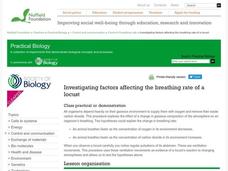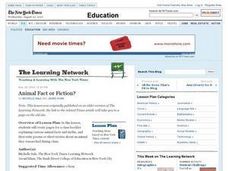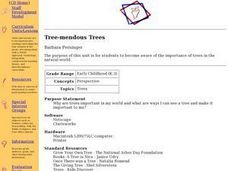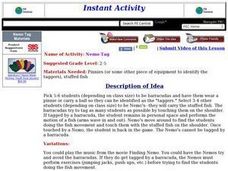Nuffield Foundation
Dissection of the Ventilation System of a Locust
Jiminy cricket! If you find yourself plagued by fear of dissection, these locust respiratory system dissection directions will walk you through everything you need to know. Teens inspect a living locust to begin with, then jump over to...
Nuffield Foundation
Investigating Factors Affecting the Breathing Rate of a Locust
Do animals breathe faster when given more oxygen or more carbon dioxide? Young scientists observe the respiration rates of locusts under a variety of gas concentrations to answer that very question. They collect data, analyze the...
Curated OER
Animal Fact or Fiction?
Read and discuss the article "Welcome to Cicadaville (Enter at Your Own Risk)" to gain a better understanding around the confusion regarding cicadas and locust swarms. In groups your young analysts research statements about animals to...
Curated OER
Migration Mania
Students explore the migratory patterns of four different animals. Reasons for the migration and migratory distances are investigated in this activity.
Silos & Smokestacks National Heritage Area
Life as a Pioneer
Students examine historical documents and research why early pioneers settled on the Iowa prairie. They review maps, describe the impact of railroading, describe life in pioneer times, and identify the effects of drought, prairie fire,...
Curated OER
Vocabulary Reading Comprehension-Grade Five
In this vocabulary comprehension instructional activity, students read a passage about locust, then complete 7 multiple choice questions. An answer key is provided.
Curated OER
Positive/Negative Bugs
Bugs can be creepy - and fun! Kids create a positive and negative design by repeatedly drawing a simple insect overlaid with a geometric shape. The outcome is really neat and will help build spacial reasoning, visual acuteness, and...
Curated OER
The Green Truck Garden Giveaway
Young scholars read "The Green Truck Garden Giveaway" and explore the hobby of gardening. After observing illustrations in the book, students predict possible events in the story. They discuss gardening and write a story about a...
Curated OER
What Type of Skeleton?
In this skeletons worksheet, students look at 7 animals and choose which of the following skeletons they have: an internal skeleton, an external skeleton or no skeleton at all. Students draw lines from each choice to each animal.
Curated OER
Living Amendments to Our Constitution
Students review the articles of the Constitution and identify the amendments to the Constitution. They use the skills of analysis and synthesis in matching the present day situation with the correct Amendment that applies.
Curated OER
Animals in the Media
Sure to activate young minds, this resource asks learners to consider how media influences their personal points of view. Pupils examine how animals are portrayed in the media to understand why they feel the way they do about those...
Curated OER
Collective Nouns
For this grammar worksheet, students read the definition of collective nouns. They complete 17 phrases using the words from a word bank at the bottom of the page. They write more collective nouns on the back of the page.
Curated OER
"Some Excellent Dumb Discourse:" Caliban as native American
Explore The Tempest and how language and power are intertwined in the play. Through a series of questions (provided) and an intense activity that has groups translate Caliban's speech into American Sign Language, learners recognize...
Curated OER
Migration Nation
Students study the concept of animal migration. They explore the migratory patterns of four different animals. Specifically, they search for on-line information about the natural history of animals and explore reasons why animals might...
Curated OER
English Exercises: Animals 1
In this animal names interactive instructional activity, students use drop down menus to choose the name of each of 15 animals that are pictured. They submit their answers using the "Done" button.
Curated OER
The Final Word
Middle schoolers research biographies of Americans who advanced science. They create an obituary for the person to share what information they have gathered. They discuss the importance of the obituary as the "final word" of a person to...
Curated OER
Tree-mendous Trees
Students become aware of the importance of trees in the natural world. Students are shown 2 filmstrips - Special Things About Trees and Tree Magic. Students plants seeds. They, students predict the growing chart of tree growth. Students...
Curated OER
"Some excellent dumb discourse:" Caliban as native American
Twelfth graders explore some of the colonial implications of The Tempest, analyzing how language and power interrelate in the play and using another American voice, American Sign Language, to consider the different forms of communication...
Curated OER
Nemo Tag
Students participate in tag games to exercise. They are divided into two groups: barracudas and Nemo fish. Barracudas tag as many students as possible. Once tagged,t he students perform fish motions, in place, until a "Nemo" touches...
Curated OER
Collective Nouns
In this collective nouns worksheet, students complete fifteen sentences by placing in each one the correct collective noun from the noun bank provided.
Curated OER
Passover Alphabetical Order Worksheet
In this online interactive Passover worksheet, students examine 16 Passover-related words and then write them in alphabetical order on the lines provided. This worksheet may also be printed for classroom use.
Curated OER
Passover Word Jumble
In this online interactive Passover worksheet, students examine 20 Passover-related words in a word bank. Students use the word bank to unscramble 20 sets of letters. This worksheet may also be printed for classroom use.
Curated OER
Following the Blood
Pupils rehearse a scene from Julius Caesar and analyze how the physical aspects of stage direction impact the audience. In this Julius Caesar lesson plan, students use blood in the scene and analyze the direction and where the blood is...
Curated OER
Ted Hughes "Pike"
Students analyze how a poet uses language to capture creatures and draft a poem on a 'sinister' animal. In this poetry analysis lesson, students read Ted Hughes' poem 'Pike' and analyze pictures of pike fish. Students use their research...

























